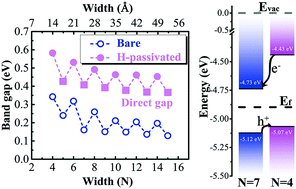Even–odd oscillation of bandgaps in GeP3 nanoribbons and a tunable 1D lateral homogenous heterojunction
Abstract
GeP3 is a new kind of IV–V two dimensional material that has been predicted very recently. Here, we have theoretically explored the electronic properties of GeP3 nanoribbons (NRs) by employing first-principles calculations within density functional theory. We find that, unlike other monolayer materials, the bandgaps of armchair GeP3 NRs exhibit a strong even–odd oscillation as a function of nanoribbon width and such oscillations can remain intensive even when the width reaches up to 9 nm. The underlying physics of such oscillation originates from both the parity-dependent geometric symmetry and quantum size effects. Furthermore, we also find that suitable chemical decoration at the nanoribbon edge, e.g., by passivating hydrogen atoms, effectively tunes the indirect band gap into a direct one, making these nanoribbons potentially important for photovoltaic applications. Based on the strong bandgap oscillating nature of GeP3 NRs, we have conceptually designed a lateral homogenous heterojunction, constructed by GeP3 nanoribbons with different widths, which has shown a type-II band alignment beneficial for photo-detector applications.



 Please wait while we load your content...
Please wait while we load your content...